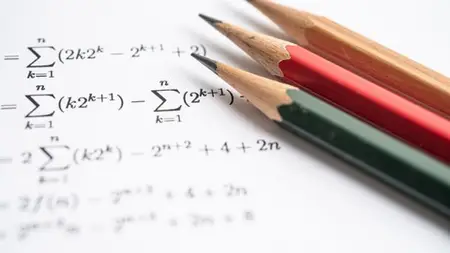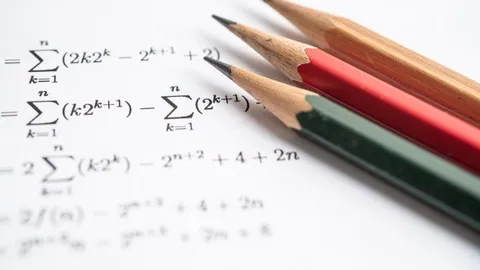Advanced Calculus; Part One: The Fundamentals
Published 8/2024
MP4 | Video: h264, 1920x1080 | Audio: AAC, 44.1 KHz
Language: English | Size: 1.20 GB | Duration: 5h 41m
Published 8/2024
MP4 | Video: h264, 1920x1080 | Audio: AAC, 44.1 KHz
Language: English | Size: 1.20 GB | Duration: 5h 41m
Sequences; Limits, Limit Supremums; Uniform (/Absolute/Lipschitz) Continuity; Compact and Connected Sets, Metric Spaces
What you'll learn
the rigorous mathematics behind undergraduate calculus and learn new deeper concepts
to prepare for Qualifying (a.k.a. Prelim) Exams in graduate programs, e.g. in USA institution
to write rigorous and accurate mathematics proofs using proper style and conventions
to combine different ideas to produce solutions by doing actual exam questions
Requirements
Undergraduate Calculus (single variable), basic notation from set theory and logic
Description
This course will provide you with the rigorous mathematics that underlies calculus. You will see proofs of results you have seen in undergraduate calculus and be introduced to much deeper notions, such as compact sets, uniform continuity, Lipschitz continuity, limit supremum, etc., all in the generality of metric spaces as well. By working on difficult homework questions, chosen from actual exams, you will be ready to take Qualifying, a.k.a. Prelim, exams in graduate schools. This course can also help with GRE in math subject.You will learn how to write accurate and rigorous proofs. I will show you how to approach a problem and how to bring together scattered observation to formulate a proof. Then, via examples that I do myself, I show you how to present your solutions in a coherent and rigorous way that will meet the standard expected of graduate students (in qualifying exams).In this part 1, we coversequences, and their limits (in metric spaces)limit supremum and limit infimumcontinuity and semi-continuityseries, convergence teststopological definition of continuitycontinuous functions on compact setscontinuous functions on connected setslocal propertiesmodulus of continuityuniformly continuous functions, Lipschitz and Hölder maps, absolutely continuous functionsA possible future course will cover single-variable differential and integral calculus: uniform convergence of sequences and series of functions, equi-continuity, power series, analytic functions and Taylor series. A whole separate course (or even two) is needed to cover multivariable calculus – but that is far into future.Here is how material is organized:Video Lectures. Each section (7 total) begins with lectures that cover definitions, provide key examples and counter-examples, and present the most important theorems, accompanied with proofs if the proofs are instructive.Homework sets with prelim questions. The first lecture of each section contains a downloadable PDF containing question from past prelim exam (or at a comparable difficulty level to them). This is your homework! You are encouraged to spend as much time as you can to try to find solutions on your own.Solutions to select exercises from homework sets. In the last video lectures of each section, I show solutions to the *-ed exercises from the homework. I do not just give you a final clean solution. Instead, I walk you through the (initially messy) process that leads one to discover a solution. I teach you how to make small observations and then bring them together to form a solution. Finally, I show you how to write math in a rigorous way that will meet standards of exams and of mathematical conventions. This latter skill cannot be overlooked.I am so excited to have this course out and cannot wait for your feedback.
Overview
Section 1: The Real Numbers
Lecture 1 Very Quick Intro to Course!
Lecture 2 The Real Numbers, Completeness Axiom
Lecture 3 Solution: Limit of a Sine sequence
Lecture 4 Solution: Increasing function has fixed point.
Lecture 5 Solution: an integral
Section 2: Sequences (also in Metric Spaces)
Lecture 6 Metric Spaces, Examples
Lecture 7 What is a sequence?
Lecture 8 Cauchy Sequence
Lecture 9 What is a sub-sequence?
Lecture 10 Limit Supremum, limit infimum
Lecture 11 Solution. Every subsequence converges to x, then…
Lecture 12 Solution. Limsup of root less than ratio
Section 3: Series, of Real or Complex Numbers
Lecture 13 What is a series?
Lecture 14 Cauchy condition for series
Lecture 15 Series with positive terms
Lecture 16 Absolute convergence and alternating series test
Lecture 17 Root test is better than ratio test!
Lecture 18 Solution. Sum Sqrt(a_n)/n converges, Cauchy-Schwarz
Lecture 19 Solution. Sum tang(1/n^p) convergence
Lecture 20 Solution. Limsup (sum a_n)/(sum b_n)
Section 4: Limit and Continuity at a Point
Lecture 21 Limit and Continuity at an Accumulation Point
Lecture 22 Limit Supremum at an Accumulation Point
Lecture 23 Upper-semicontinuity, Lower- semicontinuity
Lecture 24 Solution: limits at end of interval
Section 5: Continuous Functions and Compact Sets
Lecture 25 Topological Definition of Continuity
Lecture 26 Compact Sets, Sequential Compactness
Lecture 27 Finite Intersection Property of Compact Sets
Lecture 28 Continuous Image of Compact Sets
Lecture 29 Maximum and Minimum Exist on Compact Domains
Lecture 30 Uniform Continuity on Compact Sets
Lecture 31 Solution: diameter of compact sets
Lecture 32 Solution: fixed-set must be singleton
Lecture 33 Solution. Contractions have fixed points.
Section 6: Continuous Functions and Connected Sets
Lecture 34 Connected Sets
Lecture 35 What does it mean for a property to hold “locally”?
Lecture 36 Solution: open connected sets are path connected
Lecture 37 Solution: Derivative zero implies constancy of function on conneceted sets
Lecture 38 Solution: Antipodal points
Lecture 39 Solution: injective continuous self maps of circle
Section 7: Uniform Continuity, Absolute Continuity, Lipschitz and Hölder Continuity
Lecture 40 Different Strengths of Continuity, Modulus of Continuity
Lecture 41 Absolute Continuity, Fundamental Theorem of Calculus
Lecture 42 Lipschitz and Hölder Functions, Mean Value Theorem
Lecture 43 Uniform Continuity, Cauchy Sequences, Continuous Extensions
Lecture 44 Solution: unbounded cannot be uniformly continuous
Lecture 45 Solution: almost Lipschitz
First and second year graduate students in Math, Computer sciences, etc.,Students preparing for rigorous exams at higher education institutions (e.g. enterance exams, GRE, Preliminary or Qualifying exam),Anyone who wants to learn calculus the right way!



